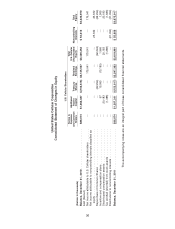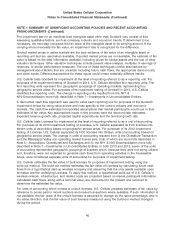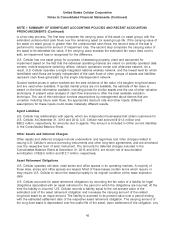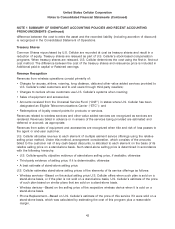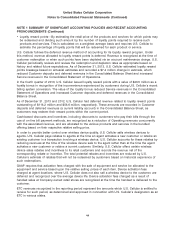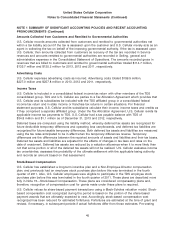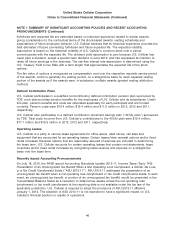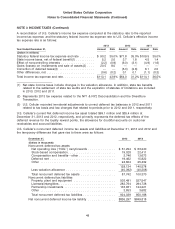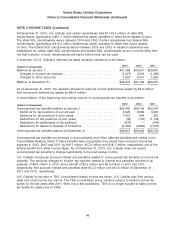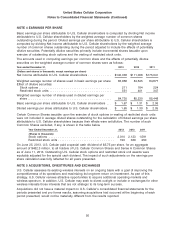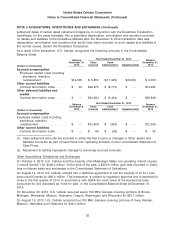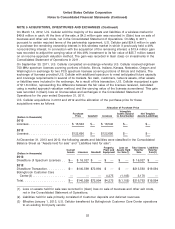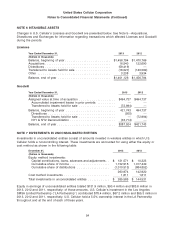US Cellular 2013 Annual Report Download - page 52
Download and view the complete annual report
Please find page 52 of the 2013 US Cellular annual report below. You can navigate through the pages in the report by either clicking on the pages listed below, or by using the keyword search tool below to find specific information within the annual report.United States Cellular Corporation
Notes to Consolidated Financial Statements (Continued)
NOTE 1 SUMMARY OF SIGNIFICANT ACCOUNTING POLICIES AND RECENT ACCOUNTING
PRONOUNCEMENTS (Continued)
• Loyalty reward points—By estimating the retail price of the products and services for which points may
be redeemed and dividing such amount by the number of loyalty points required to receive such
products and services. This is calculated on a weighted average basis and requires U.S. Cellular to
estimate the percentage of loyalty points that will be redeemed for each product or service.
U.S. Cellular follows the deferred revenue method of accounting for its loyalty reward program. Under
this method, revenue allocated to loyalty reward points is deferred. Revenue is recognized at the time of
customer redemption or when such points have been depleted via an account maintenance charge. U.S.
Cellular periodically reviews and revises the redemption and depletion rates as appropriate based on
history and related future expectations. As of December 31, 2013, U.S. Cellular estimated loyalty reward
points breakage based on actuarial estimates and recorded a $7.4 million change in estimate, which
reduced Customer deposits and deferred revenues in the Consolidated Balance Sheet and increased
Service revenues in the Consolidated Statement of Operations.
In the fourth quarter of 2013, U.S. Cellular issued loyalty reward points with a value of $43.5 million as a
loyalty bonus in recognition of the inconvenience experienced by customers during U.S. Cellular’s recent
billing system conversion. The value of the loyalty bonus reduced Service revenues in the Consolidated
Statement of Operations and increased Customer deposits and deferred revenues in the Consolidated
Balance Sheet.
As of December 31, 2013 and 2012, U.S. Cellular had deferred revenue related to loyalty reward points
outstanding of $116.2 million and $56.6 million, respectively. These amounts are recorded in Customer
deposits and deferred revenues (a current liability account) in the Consolidated Balance Sheet, as
customers may redeem their reward points within the current period.
Cash-based discounts and incentives, including discounts to customers who pay their bills through the
use of on-line bill payment methods, are recognized as a reduction of Operating revenues concurrently
with the associated revenue, and are allocated to the various products and services in the bundled
offering based on their respective relative selling price.
In order to provide better control over wireless device quality, U.S. Cellular sells wireless devices to
agents. U.S. Cellular pays rebates to agents at the time an agent activates a new customer or retains an
existing customer in a transaction involving a wireless device. U.S. Cellular accounts for these rebates by
reducing revenues at the time of the wireless device sale to the agent rather than at the time the agent
activates a new customer or retains a current customer. Similarly, U.S. Cellular offers certain wireless
device sales rebates and incentives to its retail customers and records the revenue net of the
corresponding rebate or incentive. The total potential rebates and incentives are reduced by U.S.
Cellular’s estimate of rebates that will not be redeemed by customers based on historical experience of
such redemptions.
GAAP requires that activation fees charged with the sale of equipment and service be allocated to the
equipment and service based upon the relative selling prices of each item. Device activation fees
charged at agent locations, where U.S. Cellular does not also sell a wireless device to the customer, are
deferred and recognized over the average device life. Device activation fees charged as a result of
handset sales at Company-owned retail stores are recognized at the time the handset is delivered to the
customer.
ETC revenues recognized in the reporting period represent the amounts which U.S. Cellular is entitled to
receive for such period, as determined and approved in connection with U.S. Cellular’s designation as an
ETC in various states.
44




